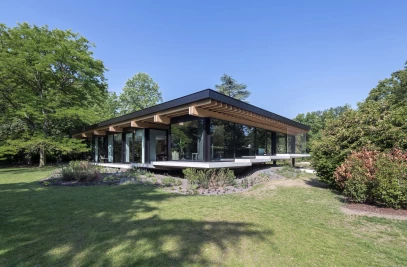Since more than 130 years, ‘Hooghuys’ is part of the the site Lorette Convent, composed of different wings surrounded by the Drabstraat, the Begijnenstraat and the Graspoort. The city block of Lorette Convent is characterised by two outer spaces, a triangular large courtyard and a more rectangular like smaller space. Since 1989 the site was abandoned. A vacancy of more than 20 years turned the site and the Hooghuys into a ruin. Convertion of the Lorette convent site into a mixed project of dwellings and offices.
In 2009 the buildings of the Lorette Convent were finally sold to 2 different real estate developers. The wing along the Begijnenstraat erected in neo gothic style was sold to a developer from Antwerp who turned it into loft apartments and dwellings. The outer spaces and the buildings along the Drabstraat were sold to developer City II Site who commissioned dmvA to make an urban plan. Urban concept of the site Lorette Convent The main idea of our proposal for the urban concept was to give back the Lorette Convent to the inhabitants of Mechelen by ‘repairing’ the urban fabric.
The former private outer places were turned into semi-public spaces by creating alleys. Most important interventions were creating a parking under the triangular cartyourd and demolishing an old building adjacent to the Hooghuys. The new edifice houses different apartements, a commercial space and the parking ramp. A cantilevered part of this new building serves as a canopy giving acces to the Hooghuys and the whole site. Architectural concept of the ‘Hooghuys’ Protected monuments always need a function to survive.
The real estate developer had bought the Hooghuys and dind’t know how to handle it. City II Site was not aware of the complexity of developing a monument. Because the Hooghuys was very important in our uban plan and because our former office was too small, the idea grew to buy this historical building. There was just one problem : the building was too big for us (1000 m2) and we had not enough money. We searched and found a partner with Mahla lawyers who were also looking for more office space. Finally Mahla bought the ground and the first floor, dmvA bought the 2 upper levels with the marvalous timber roof construction. Nowadays, due to its strategic location at the head of the urban block, the Hooghuys is evolved to the katalist of the whole site. Our approach for the restoration of the Hooghuys is based on two keywords, respect and dialogue old – new.
All the façades are restored considering that all style periods are important, so the façades are painted with white texture paintings. The interior restoration was based on the same design attitude. IN 1825 the basis of the warehouse Hooghuys was converted into a town house. The typical 19th century interior of the ground and first floor characterised by ceilings with marvavous decorated plasterwork and ‘corniches’ was completely restored. In contrast with the white painted shared entrance, the monumental spiral staircase that leads to dmvA’s office on the second floor was after restoration painted black in order to make a difference between funcional spaces and circulation spaces.
New added contemporary elements as the oversized lights , new cupboards and new doors are clearly visible in the classical interior. Interior concept of dmvA office : ‘no nonsense interventions’ First step in the restoration process was demolishing the different separating walls of the former rooms for the maids in order te create one open landscape office. Secondly, the timber roof construction is repaired and restored. Thirdly, from point of view te keep the timber roof construction visible, the pitched roof is well insulated by maens of the sarking roof insulation (insulation is placed on the exterio side of the roof). Initially the storage attic had a rectangular floorplan.
Because the volume of the staircase (an addition of the 19th century ) is a strange element in the marvolous space, it is wrapped in with ‘cupboards’ covered with mirrors in order to ‘restore’ the space. Floor to ceiling mirrors make the stairs invisible. Office desks are made of doors supported by custom-made crow’s-foot like recycled timber. ‘Trolleys’ are used as movable drawer units and storage. Those ready-mades symbolyse dmvA’s no-nonsense approach to architecture.

































